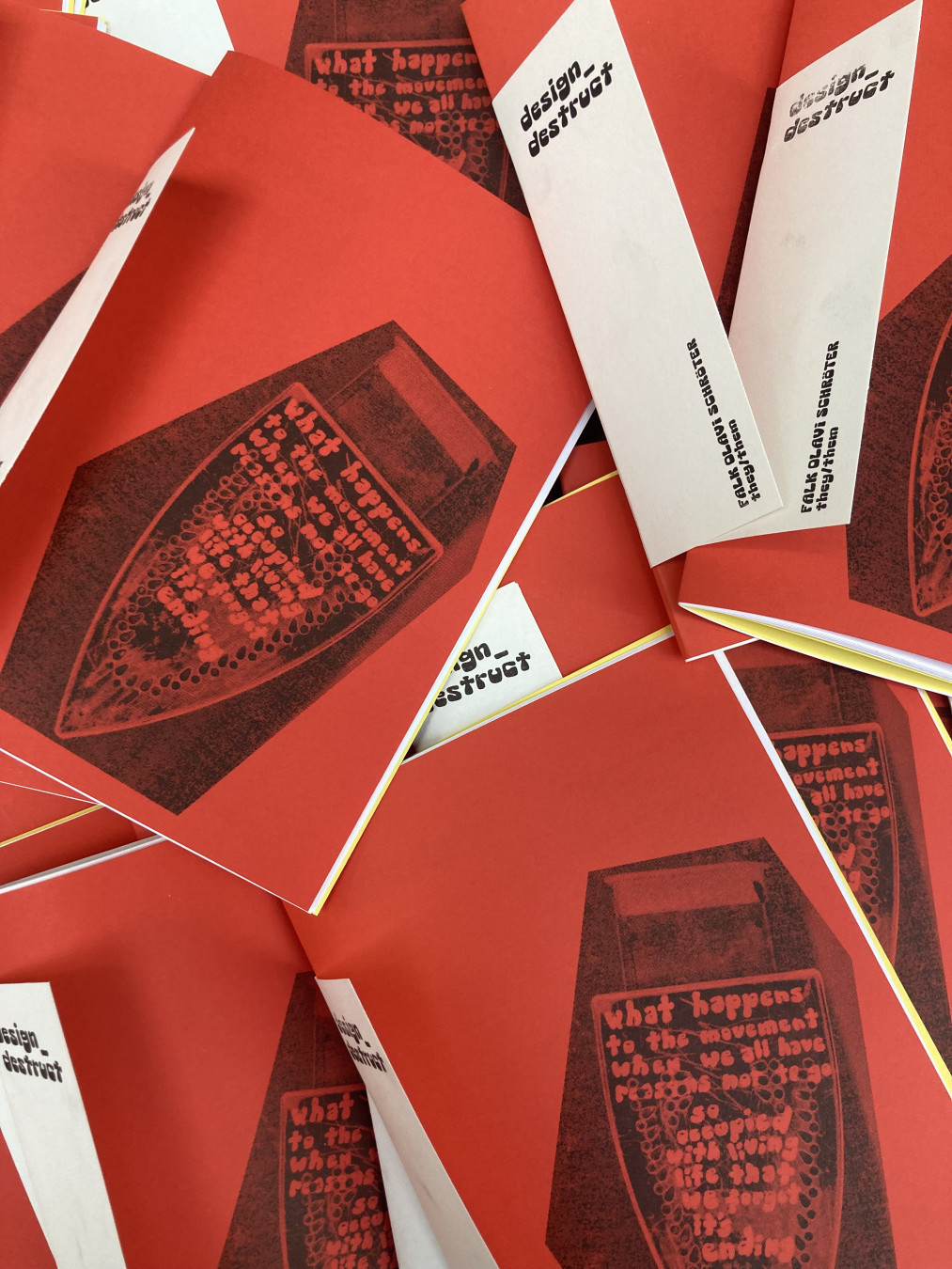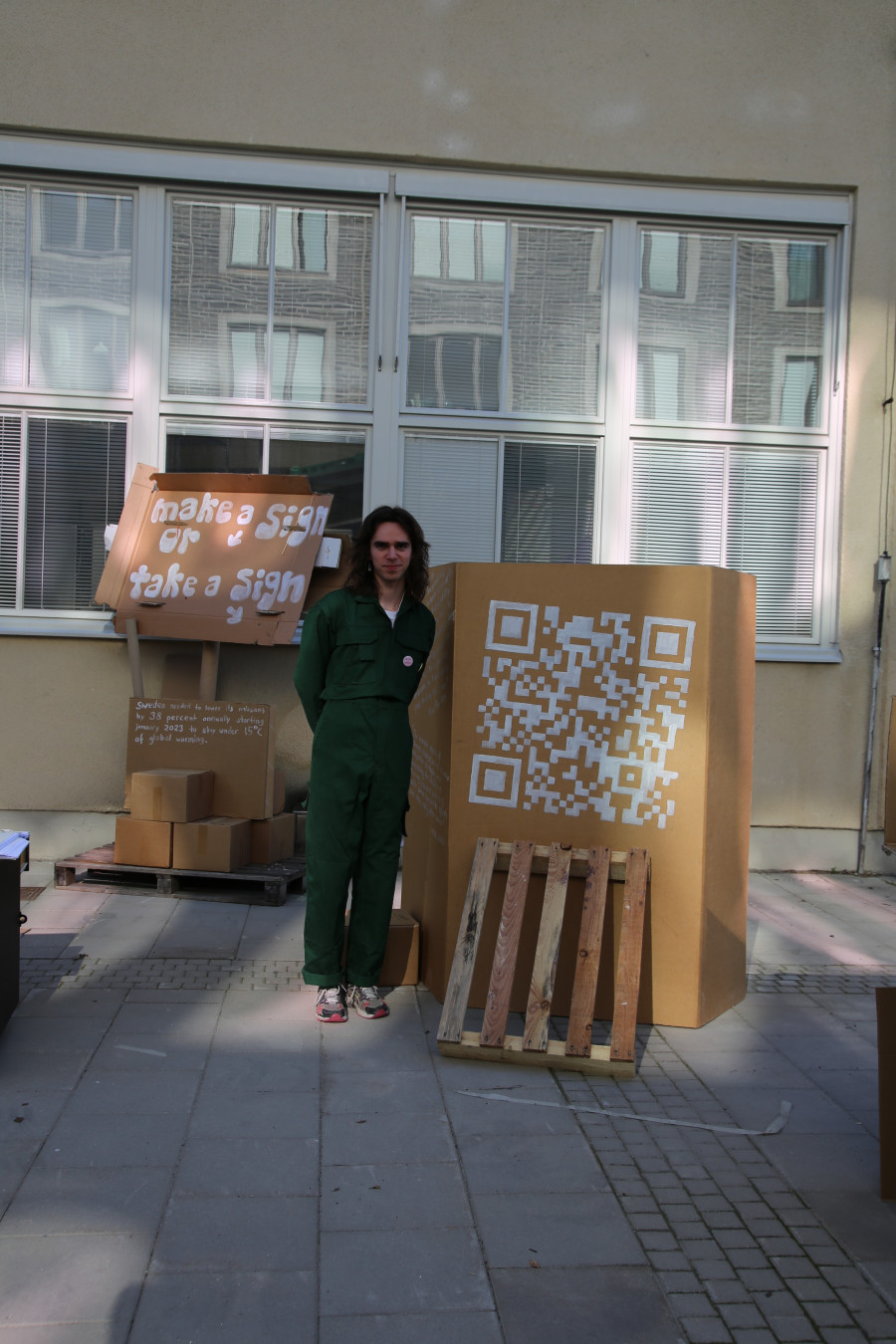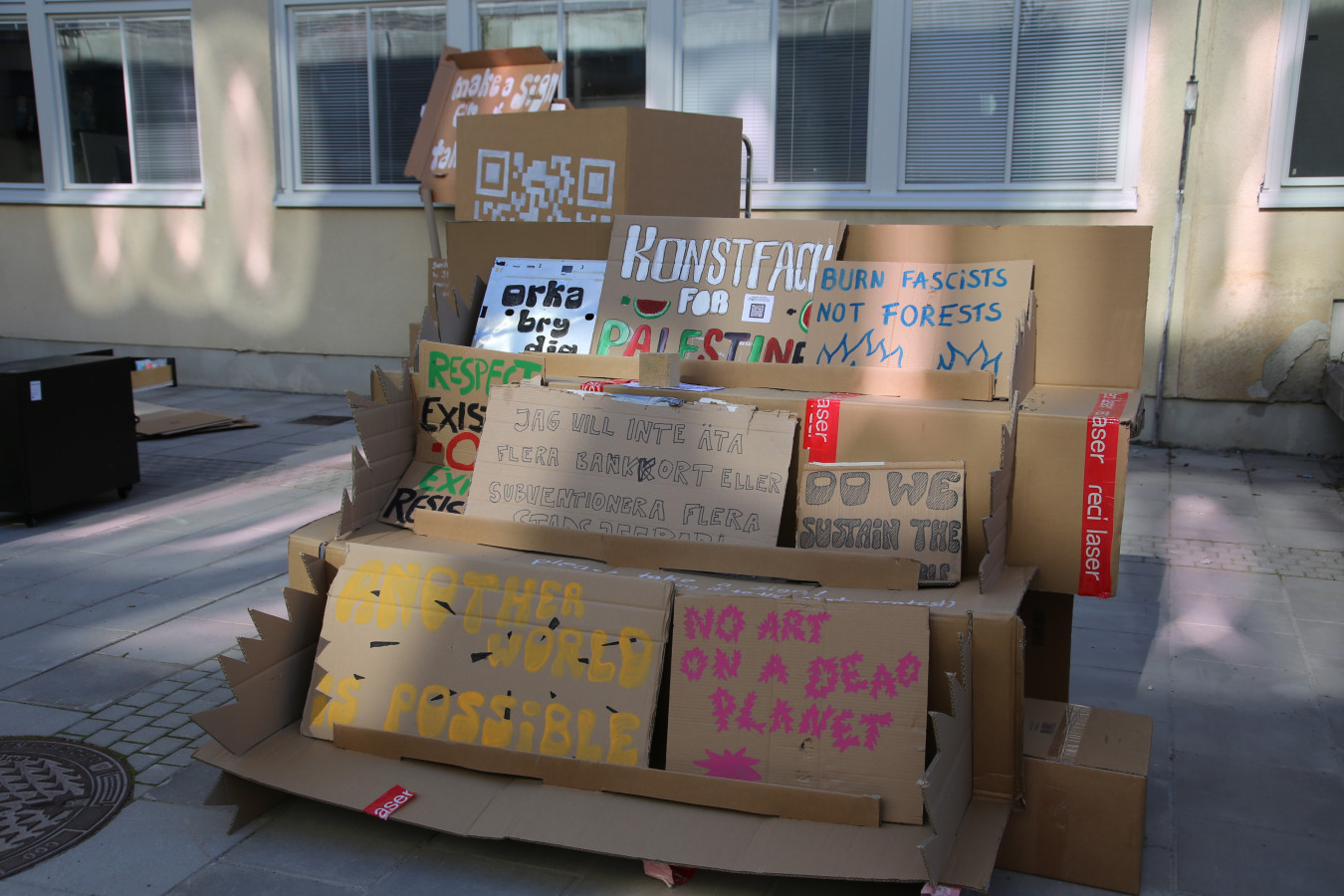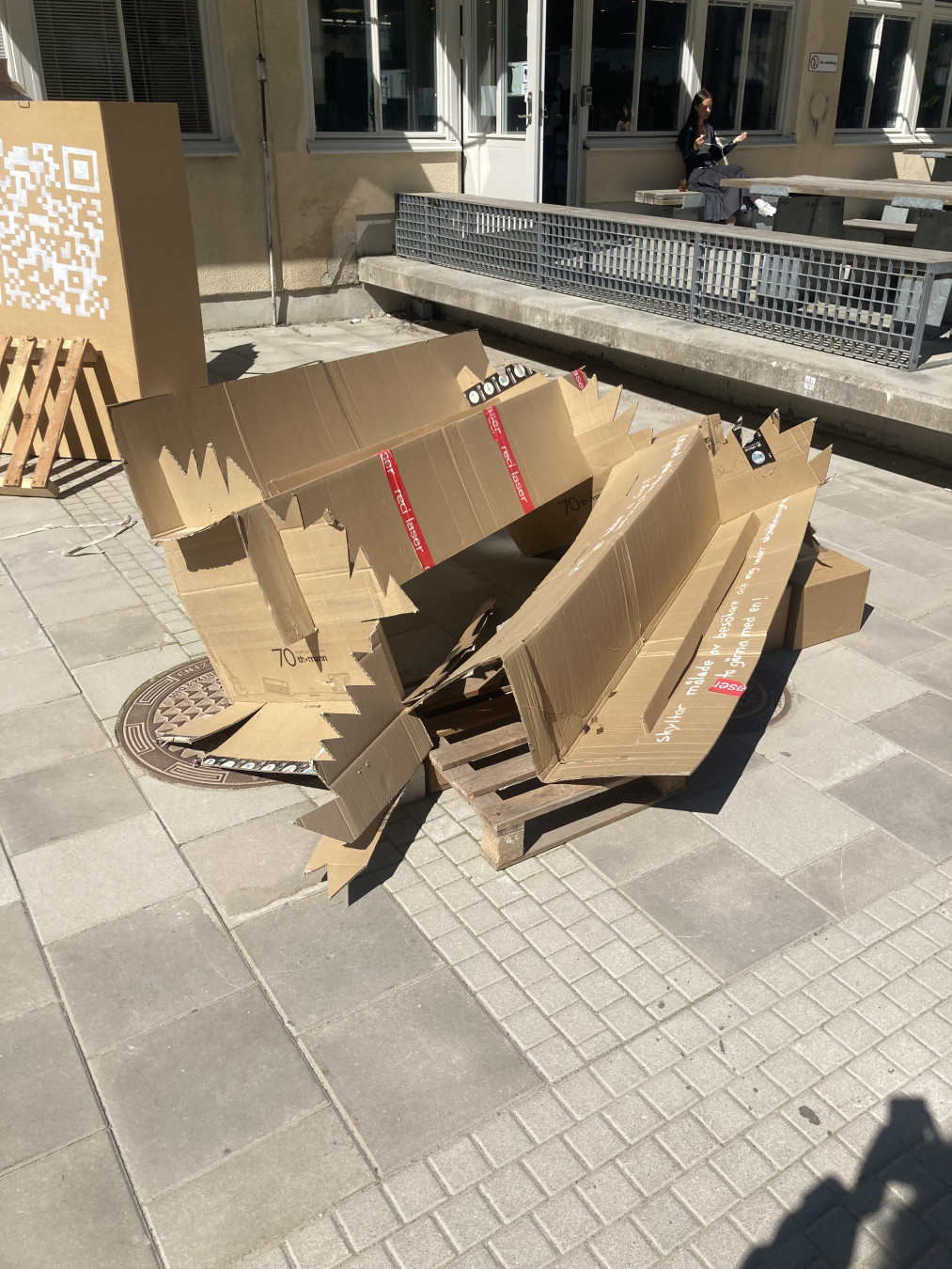

For the final intervention of my project, i wanted to use the platform of the Konstfack 2024 Spring Exhibition, my degree show, to once more educate and mobilise. To be as visible as possible, i chose to work outside, next to the university's main entrance.
One conclusion from the sign workshop that i hosted at Konstfack in April had been that a lot of the stress going into the preparation of these kinds of interventions—much like for protest preparation—comes from the need to gather large amounts of people for the event to seem effective. To prevent that stress in the planning of the exhibition, i wanted to make sure that the space would seem complete regardless of the amounts of visitors. This meant creating an engaging environment that was inviting but also well-rounded on its own.
To make my research and conclusions accessible to as many people as possible, i printed 100 copies of my thesis as an A5-zine. As a printing technique, i chose digital duplication (Riso-printing) again, which allowed me to print the 36 A5 pages quickly and cheaply. The paper i chose was standard photocopy paper, readily available at the school, and i used some red- and yellow-coloured sheets for highlights and a slightly thicker cream white paper around the cover. Then, i spent a day cutting, sorting, creasing, stapling and folding all of the zines together.

Since i had a quite large area outside the university building at my disposal, i chose to work with my concept of trash posters again, but in a much larger space. The weather forecast did not predict a significant amount of rain during the exhibition, which enabled me to use cardboard as the main building material, useful because of it's structural properties and general abundance in Konstfack's waste containers. The process turned into a playful exploration of found material and ways to combine it; and it resulted in a collection of spacial structures that mobilise, educate and invite to discussion. The visitor gets greeted by a 3 meter wide curved sign with the poem that i wrote after the previous sign workshop, as well as a large artefact consisting of cardboard and the car bumper that i had used to announce the last sign workshop—i wrote the opening quote of this essay on the car part, and and an announcement of the climate demonstration on the 31st of May on the cardboard. The centrepiece of the exhibit is a table with a large sign reading "DEMOCRACY NEEDS PROTEST" for people to sit and paint. To make it easy for visitors to read about the work, i hand-painted a large QR-code with a link to my project page, and built a podium for my printed thesis.

All around the space, i placed found trashed design objects that i wrote quotes from this thesis text on. For showing and collecting all the signs that people would create during the exhibition, i built a display out of cardboard.
As soon as i could move the building process outside, into the space, i did. This meant i could spend a week adapting to the unexpectedly strong winds that pushed over my structures, by finding new ways to lean, weight and angle them.
On the 15th of May at 14:00, Konstfack's vice-chancellor and the exhibition curators officially opened the Spring Show.
During the following two weeks, i involuntarily explored the myriad of ways that cardboard can fall over, collapse, fold, slide, and blow away, thanks to winds that seemed to increase by the daily, and blew in directions that i didn’t know were physically possible. Every morning needed to be started off by accommodating new conditions and rebuilding what had been pushed out of place. Luckily, the material itself was quite resilient, so that even if things collapsed, they just collapsed into their different building blocks.

During the exhibition's opening hours, i sat at my spot, painting signs, ready to talk to people that stopped by. But not too many did. Many stopped to read the poem out front but then continued on, hopefully keeping it in mind even as they did not engage with it further.
Despite my efforts to accommodate different levels of engagement from the public, i failed to effectively alleviate the stress that comes with hoping to reach a broad audience.

In what i would describe as a stereotypically Swedish act of silent (and socially avoidant) protest, i discovered several bits of Portion Snus on some of my structures when i came in one morning. That was the most confrontation—both negative or positive—that i experienced during the exhibition, part of a larger picture in which the confrontational and critical aspects in my work did not actually get acknowledged.
In an article for Dagens Nyheter, Bo Madestrand described the exhibition as largely apolitical, declaring students to be self-centred, and conveniently missing the openly political and interactive projects exhibited by the teachers education, visual communicators and designers that span a large part of the exhibit (Madestrand, 2024). This fit into a larger media landscape that seemed to actively ignore the politics in many of the works in order to construct a narrative of a depoliticised and mature arts school that had departed from its long history of unrest; a narrative that in turn complements Konstfack's recent attempts to appeal to Sweden's hard-right, "anti-woke" government (read more in >hitting a nerve<), in a time when a clear and unwavering stance is desperately needed.
The day the exhibition opened, more than 35000 Palestinian people had been killed by the Israeli military in the Gaza strip since October (Reuters, 2024). A report released in April by UN Special Rapporteur Francesca Albanese stated that there were "reasonable grounds" to believe Israel was committing a genocide (UN news, 2024). On Monday, the 20th of May, halfway into the exhibition, the international criminal court sought an arrest warrant for Israel's prime minister Benjamin Netanyahu, his minister of defence and 3 Hamas officials (McKernan, 2024).
If there ever had been a “normal” time for the spring exhibition to take place, this was not it.
On top of the moral imperative to opposing these atrocities, a fight against them is central to an intersectional struggle for Climate Justice:
"Climate Justice opposes military action, occupation, repression and exploitation of lands, water, oceans, peoples and cultures, and other life forms"
— International Climate Justice Network, 2002
Fridays For Future Sweden, as a Climate Justice movement, has been outspoken about the rights of Palestinians (Thunberg et al., 2023); banners and signs in solidarity with the people affected by Israel's war crimes are a regular occurrence at FFF Stockholm's weekly strikes and large parts of the network are also active in Palestinian liberation movements.
The day before the exhibition opened, students at Stockholm University (SU) and the Institute of Technology (KTH) started solidarity encampments, inspired by student movements in the US and spreading around the globe, calling on their schools to stop collaborating with Israeli institutions and weapons manufacturers (Sadikovic et al., 2024).
At Konstfack, the group Konstfack For Palestine handed out flyers outside the Spring Exhibition calling for Konstfack to cut it's ties with the Israeli Bezalel Academy of Art and Design because of its support of Israel's military and discrimination of Palestinian students. My exhibit became an addition to the group's work, providing organisers and visitors with materials and space to make signs and mobilise. To further support Konstfack For Palestine and the encampments at SU and KTH, i was part of a group of students that gathered in the main exhibition space during the vernissage to design and print mobilisation material.
Despite the urgency and severity of the situation, Konstfack's response was slow and avoidant as it once again scared away from taking a stance, or acting on student criticisms.
My building plans had worked out well and my exhibit took up a lot of space, as i had hoped; people stopped to look and sometimes even talk to me and quite a few of them painted signs. But the general reception left me quite disappointed with the way that challenges to Konstfack's status quo are handled. At best, i got recommendations for further reading or the recognition that the work was current and important, but none of it ever seemed to translate into a remote interest in acting on—or even just reacting to—my criticism. Looking at the need for immediate and radical responses to the crises and atrocities that this work is trying to fight, i am left with a feeling of anxious desperation.

As a fitting end to the project, it rained on the morning of the last day the exhibition had open. It felt right to finally give in to the weather, which i had been in a constant dance with, pushing back against the wind and moving around to stay in the shade; finally letting my structures wilt and bend, signalling their impermanence and mirroring my own mental and physical exhaustion.
Going forward, my hope is for my work and the struggles it highlights to actually be taken seriously, lead to active discussions and real change.
Reuters (2024). Gaza death toll: how many Palestinians has Israel’s campaign killed. [online] Reuters. Available at: https://www.reuters.com/world/middle-east/gaza-death-toll-how-many-palestinians-has-israels-campaign-killed-2024-05-14/ [Accessed 26 May 2024].
UN news (2024). Rights expert finds ‘reasonable grounds’ genocide is being committed in Gaza | UN News. [online] news.un.org. Available at: https://news.un.org/en/story/2024/03/1147976 [Accessed 26 May 2024].
McKernan, B. (2024). ICC prosecutor seeks arrest warrants for Israeli PM and Hamas officials for war crimes. The Guardian. [online] 20 May. Available at: https://www.theguardian.com/law/article/2024/may/20/icc-prosecutor-seeks-arrest-warrants-israeli-pm-netanyahu-hamas-officials-war-crimes [Accessed 26 May 2024].
International Climate Justice Network (2002). Bali Principles of Climate Justice. [online] www.corpwatch.org. Available at: https://www.corpwatch.org/article/bali-principles-climate-justice [Accessed 4 Apr. 2024].
Sadikovic, A., Mahmoud, A., Hedberg, K., Grosshög, H., Hansson, A. and Ingemarsson, J. (2024). Pro-palestinska demonstranter slog läger utanför svenska universitet. [online] DN.se. Available at: https://www.dn.se/sverige/pro-palestinska-demonstranter-slar-lager-utanfor-svenska-universitet/ [Accessed 26 May 2024].
Thunberg, G., Nilsson, A., Mater, J. and Frescia, R. (2023). We won’t stop speaking out about Gaza’s suffering – there is no climate justice without human rights. The Guardian. [online] 5 Dec. Available at: https://www.theguardian.com/commentisfree/2023/dec/05/gaza-climate-justice-human-rights-greta-thunberg [Accessed 26 May 2024].
Madestrand, B. (2024). Konstfacks studenter ger hopp om framtiden. [online] DN.se. Available at: https://www.dn.se/kultur/konstfacks-studenter-ger-hopp-om-framtiden/ [Accessed 26 May 2024].